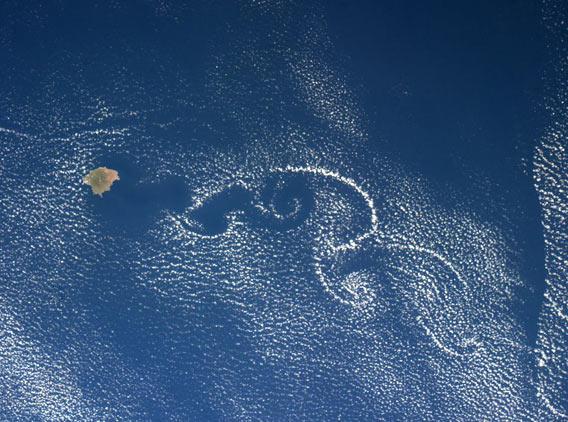“I told you!” shouted Ford, leaping to his feet. “Eddies in the space-time continuum!”
“And this is his sofa, is it?” asked Arthur.
—Douglas Adams, “Hitchiker’s Guide to the Galaxy”
Life is complex. So is fluid dynamics.
Actually, you’d think fluid motion isn’t all that complicated. Liquids flow downhill, moving around stationary objects, and generally going from point A to point B.
But in reality fluid motion is incredibly complex, one of the most ridiculously overwrought fields in all of mathematical physics. Turbulence, oscillations, viscosity, boundary layers: They all add up to make fluid motion fiercely hard to understand and calculate.
But in complexity there can be beauty. Commander Chris Hadfield, on board the International Space Station, took this picture on Mar. 26, 2013, showing exactly that fluidic gorgeosity:

Image credit: NASA
That is Isla Socorro, a volcanic island located a few hundred kilometers off the west coast of Mexico and the southern tip of Baja California. As wind blows past the island, lovely atmospheric swirls form on the downwind side. These swirls are called von Kármán vortices, and the long chain of them gets the name von Kármán vortex streets. The cloud pattern makes them visible to the eye.
What causes them? In detail the mathematics is quite fierce, but how it works isn’t all that hard to understand in principle.
Imagine you have a cylinder (a pencil, or a bucket, or a concrete pylon) that you place in flowing water. It’s an obstacle, and the water will flow around it.
However, near the cylinder’s surface the water slows, piling up a bit. The water farther from the cylinder is moving faster. This causes eddies (vortices) to form, curls in the water. This kind of motion is a bit unstable, and can cause a slight force, pushing the water perpendicular to the direction of flow. But the water all around the flow pushes back, causing a sort of oscillation, like a pendulum swinging. The result is a series of vortices forming and flowing downstream, one on each side of the obstruction, alternating in pattern.
An animation, in this case, is worth way more than a thousand words:
See how the fluid wiggles like a tadpole tail downstream? Eventually those vortices dissipate, losing coherence due to turbulence and drag. This process from start to finish is called “vortex shedding”, which just sounds intrinsically cool.
Mind you, a fluid is anything that can flow, not just liquids. Air is a fluid, and when you have a steady wind blowing past, say, a Pacific island, you can get vortex shedding leading to von Kármán vortex streets. Here’s another fine example taken from space, showing vortices off Isla Alejandro Selkirk and Isla Robinson Crusoe off the coast of Chile.

Image credit: NASA/Jeff Schmaltz/LANCE MODIS Rapid Response
This phenomenon has everyday effects, too. Along the highway to and from my local airport there are metal warning posts with reflectors on them. The metal posts are thin sheet metal, and the wind is commonly howling along the plains there. This causes vortex shedding off the posts. This applies a force to the post, pushing it to the side. But the post is flexible, so it bounces back. If the timing of the vortex shedding is in phase with the natural time it takes the post to flex and relax you get a resonance; the vibration is reinforced, and the post will continue to oscillate.
On some days as I drive home the airport I see those posts really whipping back and forth, sometimes vibrating violently enough to rapidly move them many centimeters side-to-side (like the scene in “Close Encounters of the Third Kind” where the rotor wash from the government helicopter makes the sign posts vibrate). This can happen with car antennae and other anchored objects where there is wind blowing past them…like power lines, buildings, and tall towers. Engineers have to deal with this, because if the force gets too strong, the object can be damaged by the vibrations.
And I can’t help but mention this in parting: Isla Socorro, in that first picture at the top of this article, is part of a mostly underwater ridge that runs to the west of Mexico. The name of that particular geological feature?
Mathematicians Ridge!
Math and science are everywhere, even deep beneath—and above—the ocean waves.
Tip o’ the windbreaker to Tino Eberl for identifying the island, to Evan Hadfield (Chris’s son) for some help with the photo, and to Joe Seatter for reminding me I wanted to write about this effect!